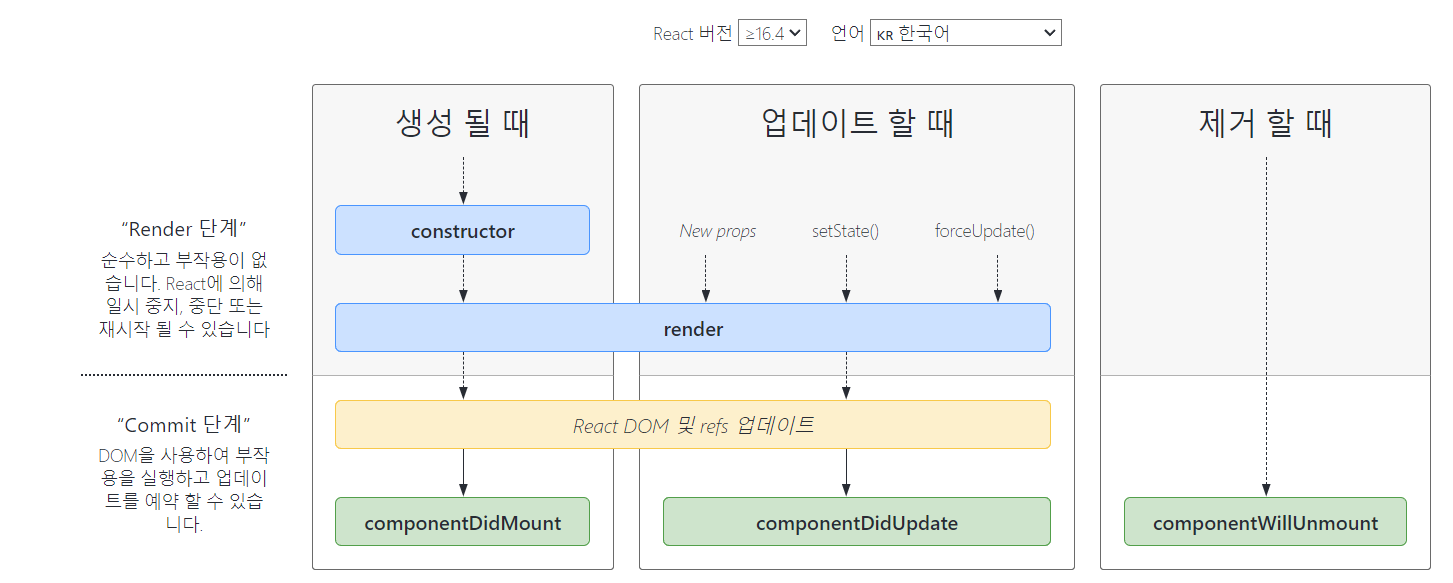< 리엑트 라이프사이클 >
호출 순서
1. 마운트시
1-1. constructor()
1-2. render()
1-3. componentDidMount()
2. 업데이트시
2-1. shouldComponentUpdate()
2-2. render()
2-3. componentDidupdate()
3. 마운트 해제시
3-1. componentWillUnmount()
4. 에러 발생에 사용되는 사용주기 메서드
4-1. static getDerivedStateFromError()
4-2. componentDidCatch()
< 리엑트 Hook >
사용규칙
1. 최상위에서만 Hook 호출해야함. 반복문, 조건문, 중첩문 함수 내에서 호출x
2. 함수 컴포넌트의 경우에만 호출, class 컴포넌트에서 호출x
1. useState
[사용법]
const [state,setState] = useState(false);
setState(true);
const [todos,setTodos] = useState([{text:'learn hooks'}])
2. useEffect
[사용법]
useEffect(()=>{
...
},[])
// []이와 같이 해주지 않으면 무한 렌더링 된다.
// 배열안에 인자값으로 넣어주는 값이 변할 때마다 새롭게 렌더링됨.3. useContext
: props로 값을 일일이 넘겨주지 않아도 가장 최상위 컴포넌트로 하위 컴포넌트를 감싸서 데이터 제공 가능
[사용법]
const themes = {
light :{
foreground:"#000000",
background:"#eeeeee"
},
dark :{
foreground: "#ffffff",
background: "#222222"
}
}
const ThemeContext = React.createContext(themes.light)
function App(){
return(
<ThemeContext.Provider value={themes.dart}>
<Toolbar/>
</ThemeContext>
)
}
function Toolbar(props){
return(
<div>
<ThemeButton/>
</div>
)
}
function ThemeButton(){
const theme = useContext(ThemeContext);
return(
<button style={{background:theme.background,color:theme.foreground}}>
button
</button>
)
}4. 기타 Hooks
- useReducer
- useCallback
- useMemo
- useRef
- useImperativeHandle
- useLayoutEffect
- useDebugValue
< 기타 >
react-router-dom
: 데이터가 변경되는 부분의 컴포넌트만 변경하는 spa(single-page-application)인
리엑트의 특성상 특정 요청에 따라 적절한 컴포넌트를 라우팅하는 것을 돕는 역할.✔ BrowserRouter?
: history API를 사용해 URL과 UI를 동기화하는 라우터.
✔ React.fragment?
: 하나의 컴포넌트에서 여러개의 엘리먼트를 return할 때 하나의 태그로 묶어서 내보내는 것을 대체하는 역할.
ex) React.fragment 사용 x
return(
<div>
<p>이와 같이 여러개의 엘리먼트가 존재할때</p>
<span>div 등의 태그로 하나로 묶어서 return해야함</span>
</div>
)
ex) React.fragment 사용 o
return(
<React.fragment>
<p>div 등의 태그로 하나로 묶어서 return하던 것을</p>
<span>React.framgment로 대체</span>
</React.fragment>
)react-router
- react-router-dom : 웹 관련 컴포넌트
- react-router-native : 앱 관련 컴포넌트.

